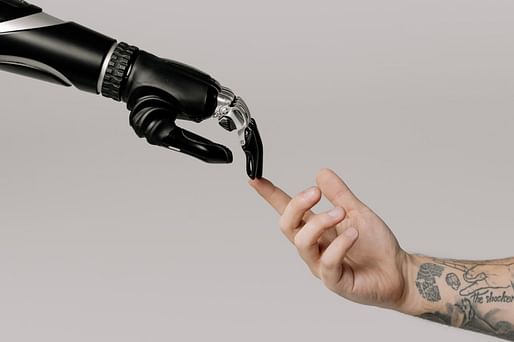

The question “Will a robot take my job?” is never too far from any discussion about the role of artificial intelligence and machine learning in the future economy. The answer to this simple, justified question is anything but clear, and continues to divide experts in economics and business trends.
As Time Magazine noted in a 2020 piece, a group of economists from MIT and Boston University estimates that 42% of the 40 million jobs lost during the COVID-19 pandemic will be permanently replaced by AI and machines, adding to the 400,000 jobs already lost to automation in U.S. factories between 1990 and 2007. To back their claim, the Time piece points to the prevailing trend of successful U.S. companies reducing their human workforce in favor of AI, in fields ranging from law and finance to DJs and…writing.
Separately, however, a 2020 MIT paper titled ‘Artificial Intelligence and Future of Work’ paints a more optimistic picture, positing that the rigid, single-task thinking still exhibited by many AI applications will inhibit its ability to replace creative, lateral-thinking professions. “For the foreseeable future,” the authors say, “the most promising uses of AI will not involve computers replacing people, but rather, people and computers working together—as “superminds”—to do both cognitive and physical tasks that could not be done before.”

Architects are no strangers to this debate. In a feature article we published earlier this year titled 'What is the Real Threat of Artificial Intelligence to the Architecture Profession?' author Karim Abdel-Wadood outlined how the dichotomy of AI presented in the broader economy, that of co-operational efficiency versus job displacement, is evident also within architecture.
While AI can help architects generate spatial analyses without physical site visits, carry out more accurate environmental analyses, or enable the design of responsive buildings that react to real-time human behaviors or desires, AI can also bring an unbiased, egoless approach to the task of building design, with time and cost savings that render the architect’s role economically unattractive to clients. As Adbel-Wadwood notes, “The threat is actually posed not by artificial intelligence itself but by users who deem AI to be a cheaper, more efficient means to an end.”

While the long-term impact of artificial intelligence on the architect’s traditional workflows and responsibilities remain unclear, our editorial has also hosted examples of architects embracing AI, machine learning, and software as platforms upon which to exercise their creative skills, and generate new career opportunities. In June of this year, we spoke with four architecture firms who have created software tools to combat climate change, all of whom articulated the view that the architect's skills in spatial organization, critical analysis, and lateral thinking all lend themselves to creating digital products.
The boundless possibilities for architects in the age of AI were also evident in our recent conversation with the acclaimed media artist Refik Anadol. Reflecting on the future role of architects in virtual space, Anadol said “I don’t believe that giving a particular function to a building in the physical environment is the architecture of the future. I feel that, perhaps, the future of sensing space is in our mind.”
This trend is equally prevalent on our jobs board, where advances in artificial intelligence are translating into new job opportunities for architects. As part of our ongoing jobs highlights series, we are focusing this week on Zenerate, an LA-based “real estate generative design company” comprised of architects, software engineers, and AI developers. Founded by Harvard and Caltech graduates, the company uses AI and data science to create software applications that deliver rapid feasibility studies for property developers and stakeholders looking to understand the financial potential of a development site. The software’s output centers on checking the viability of a site or property through rapidly generating, transforming, and reconfiguring development layout options.
Over on Archinect Jobs, the company is currently advertising for a full-time architect/architectural designer, along with a part-time project analyst, to join their Los Angeles team. Responsibilities for the architect/designer role include conducting zoning and building code research, contributing an understanding of the real-estate development industry and multifamily housing, assisting in product development, and channeling customer feedback to help build a product roadmap.

The role at Zenerate, like many in our jobs highlight series, demonstrate the ability of the architect to transcend the established convention of market-orientated real estate or commercial development, and bring an understanding of space to a wide range of job roles, including set design, remote-living brands, or visualization companies. This trait is also frequently exhibited through our Working Out Of The Box series, where the skills acquired through architectural training have given license for individuals to explore an endless list of topics, be it perfume, textiles, music, or extra-terrestrial life.
Facing the dangers and opportunities brought to the profession by AI, these real-world examples of architects adapting their skillsets to find career success captures the core advice of Adbel-Wadwood’s article: “It would be prudent for architects to reflect on how they can synthesize the more intangible aspects of their skill sets in order to be more equipped to navigate today’s rapidly shifting environments.”
--
As part of Archinect's job highlights series, we recently showcased an opportunity to work as an Architect at Soho House, a 3D Visualization Designer at Red Leaf, and a Project Manager or Design Manager at Industrious.
Stay up to date with the latest job listings by following Archinect Job's Facebook, Twitter, and Architect Jobs Instagram for new job opportunities posted. Archinect's industry-leading job board publishes approximately 150 new opportunities every week.
2 Comments
Artificial Idiocy
As of the natural kind isn't bad enough.
on the whole I think it's something to look forward to, if it can really automate things like code-check and optimizing the parts of design that can be optimized (which is a very limited range of spaces - less than many people developing these tools recognize!)
much of the labor of young architects on things like toilet rooms layouts and information organization will be totally obviated. at first that seems bad, but in reality no one aspires to those jobs and they are a pretty poor entry into the field that only creates a barrier against meaningful work and development of useful skills.
i think the biggest worry is AI just becomes another antagonist that impedes getting things done, systems that filter out individual approaches or try too hard to standardize outcomes. poorly implemented AI will be frustrating and terrible - probably half of architects work in the future will be checking the AI and overseeing the appropriate selection of models and algorithms for a given project.
Block this user
Are you sure you want to block this user and hide all related comments throughout the site?
Archinect
This is your first comment on Archinect. Your comment will be visible once approved.